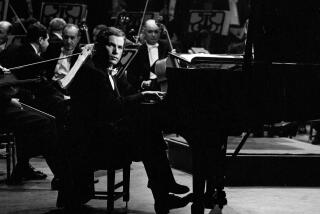Where a Little Bach Talk Is Good
- Share via
There are five small Web sites about Glenn Gould.
In addition, there are numerous sites concerning Gregorian chants, castrati, recorders, crumhorns, consorts, the viola da gamba and Hildegard of Bingen.
All these topics, and many more, fall under the heading of Early Music, defined by musicologists as the music of the Western world in the Medieval, Renaissance and Baroque eras, ending in about 1750, the year Johann Sebastian Bach died.
Early Music is a hot topic on the World Wide Web, which might be somewhat surprising because the Internet is still for the most part a silent medium. But the Web is as much about community as it is about information, and there are few communities as widespread and strong in the arts as the one that encompasses lovers of this music.
A good place to start an exploration of these topics is the exhaustive Early Music FAQ (in Web speak, these initials stand for “frequently asked questions”), located at https://www.best.com/mccomb/music/early/faq/rmefaq.htm. This site was put together by a physicist living in California, a lecturer in math at Oxford and a professor of economics who hails from France but now teaches at Johns Hopkins University.
Instead of the usual question-and-answer format of FAQs, their site is basically a series of links to others containing essays, information on recordings (including short excerpts that can be downloaded and enjoyed if your computer is a late model Macintosh or a PC equipped with a sound card), performance schedules and musings on specific topics.
The physicist, Todd Michel McComb--who explains in his bio that he has taken a break from his profession to help raise his young son and delve into other topics of interest--has contributed a short essay on “What Is Early Music.” It explains that the field is defined not only by its historical period, but also as an approach to performance of that era.
If you want to further explore performance issues, you can jump over to the newsgroup rec.music.early, where people will be more than happy to engage you in debate over just what constitutes a historically accurate performance of this or that work.
McComb notes that the study of Early Music generally begins with the Medieval era because little information about earlier music has survived. Some of the earliest composers about whom we do have evidence were women, beginning with Xosrovoduxt and Sahakdust, Armenians who lived in the early 700s. They’re mentioned on the “Women Composers Born Before 1730” site maintained at New York University.
To read about and hear some of the instruments of the Renaissance, you can click over to a site created by Yasuhiko Higaki, an electronics engineer (why is it that so many people devoted to this music work in the science field?) based in Chiba, Japan. He offers sound samples of eight instruments, including the crumhorn, recorder, tabor and shawm, and then puts them together to play a short segment of a “Danse” from the 1500s.
This little recording, which can be downloaded, is more a technological than an artistic marvel, but it does give you a better understanding of how these instruments worked together in an ensemble.
Finally, we turn to the great Bach interpreter, Glenn Gould (1932-1982). The recordings of this mysterious and eccentric Canadian pianist are spoken about by his fans with an awe usually reserved for religious deities.
I would make fun of these fans, except that I’m one myself.
These sites (begin with the “Unofficial Glenn Gould Page” at https://py2.genetics.uga.edu/PFfolder/glengould.html) are a good place to go when your significant other threatens to smash the CD player if the wondrous fourth partita is played one more time.
* Cyburbia’s e-mail address is David.Colker@latimes.com.
More to Read
The biggest entertainment stories
Get our big stories about Hollywood, film, television, music, arts, culture and more right in your inbox as soon as they publish.
You may occasionally receive promotional content from the Los Angeles Times.










